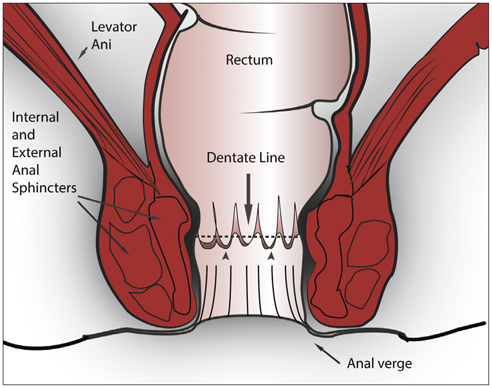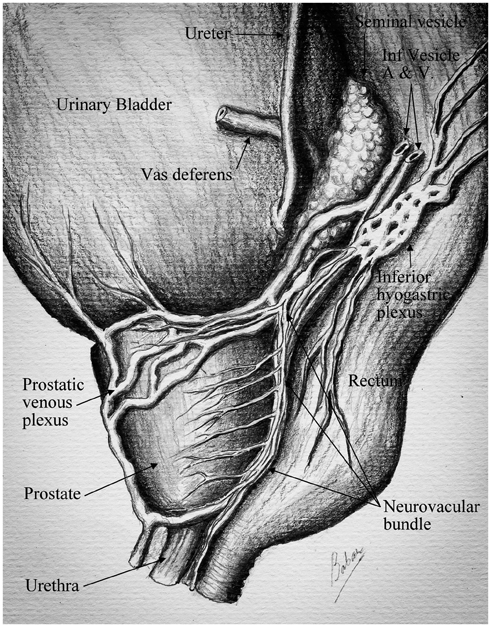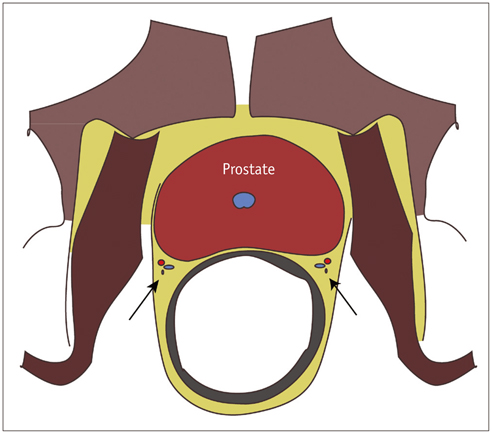Korean J Radiol.
2014 Oct;15(5):543-553. 10.3348/kjr.2014.15.5.543.
Pain during Transrectal Ultrasound-Guided Prostate Biopsy and the Role of Periprostatic Nerve Block: What Radiologists Should Know
- Affiliations
-
- 1Department of Oncologic Imaging, National Cancer Centre, Singapore 169610. bab_nazir@hotmail.com
- KMID: 1734940
- DOI: http://doi.org/10.3348/kjr.2014.15.5.543
Abstract
- Early prostate cancers are best detected with transrectal ultrasound (TRUS)-guided core biopsy of the prostate. Due to increased longevity and improved prostate cancer screening, more men are now subjected to TRUS-guided biopsy. To improve the detection rate of early prostate cancer, the current trend is to increase the number of cores obtained. The significant pain associated with the biopsy procedure is usually neglected in clinical practice. Although it is currently underutilized, the periprostatic nerve block is an effective technique to mitigate pain associated with prostate biopsy. This article reviews contemporary issues pertaining to pain during prostate biopsy and discusses the practical aspects of periprostatic nerve block.
Keyword
MeSH Terms
Figure
Cited by 1 articles
-
Comparison of prostate cancer detection rates of various prostate biopsy methods for patients with prostate-specific antigen levels of <10.0 ng/mL in real-world practice
Kyung Tak Oh, Kyo Chul Koo, Byung Ha Chung, Kwang Suk Lee
Investig Clin Urol. 2020;61(1):28-34. doi: 10.4111/icu.2020.61.1.28.
Reference
-
1. Sakr WA, Grignon DJ, Crissman JD, Heilbrun LK, Cassin BJ, Pontes JJ, et al. High grade prostatic intraepithelial neoplasia (HGPIN) and prostatic adenocarcinoma between the ages of 20-69: an autopsy study of 249 cases. In Vivo. 1994; 8:439–443.2. Ramey JR, Halpern EJ, Gomella LG. Ultrasonography and Biopsy of the prostate. In : Wein AJ, Kavoussi LR, Novick AC, Partin AW, Peters CA, editors. Campbell-Walsh Urology. 9th ed. Philadelphia: Saunders;2007. p. 2883–2895.3. Autorino R, De Sio M, Di Lorenzo G, Damiano R, Perdonà S, Cindolo L, et al. How to decrease pain during transrectal ultrasound guided prostate biopsy: a look at the literature. J Urol. 2005; 174:2091–2097.4. Torp-Pedersen S, Lee F, Littrup PJ, Siders DB, Kumasaka GH, Solomon MH, et al. Transrectal biopsy of the prostate guided with transrectal US: longitudinal and multiplanar scanning. Radiology. 1989; 170(1 Pt 1):23–27.5. Raja J, Ramachandran N, Munneke G, Patel U. Current status of transrectal ultrasound-guided prostate biopsy in the diagnosis of prostate cancer. Clin Radiol. 2006; 61:142–153.6. Hodge KK, McNeal JE, Terris MK, Stamey TA. Random systematic versus directed ultrasound guided transrectal core biopsies of the prostate. J Urol. 1989; 142:71–74. discussion 74-75.7. Norberg M, Egevad L, Holmberg L, Sparén P, Norlén BJ, Busch C. The sextant protocol for ultrasound-guided core biopsies of the prostate underestimates the presence of cancer. Urology. 1997; 50:562–566.8. Levine MA, Ittman M, Melamed J, Lepor H. Two consecutive sets of transrectal ultrasound guided sextant biopsies of the prostate for the detection of prostate cancer. J Urol. 1998; 159:471–475. discussion 475-476.9. Rabbani F, Stroumbakis N, Kava BR, Cookson MS, Fair WR. Incidence and clinical significance of false-negative sextant prostate biopsies. J Urol. 1998; 159:1247–1250.10. Stricker HJ, Ruddock LJ, Wan J, Belville WD. Detection of non-palpable prostate cancer. A mathematical and laboratory model. Br J Urol. 1993; 71:43–46.11. Presti JC Jr, O'Dowd GJ, Miller MC, Mattu R, Veltri RW. Extended peripheral zone biopsy schemes increase cancer detection rates and minimize variance in prostate specific antigen and age related cancer rates: results of a community multi-practice study. J Urol. 2003; 169:125–129.12. Presti JC Jr, Chang JJ, Bhargava V, Shinohara K. The optimal systematic prostate biopsy scheme should include 8 rather than 6 biopsies: results of a prospective clinical trial. J Urol. 2000; 163:163–166. discussion 166-167.13. Naughton CK, Smith DS, Humphrey PA, Catalona WJ, Keetch DW. Clinical and pathologic tumor characteristics of prostate cancer as a function of the number of biopsy cores: a retrospective study. Urology. 1998; 52:808–813.14. Karakiewicz PI, Bazinet M, Aprikian AG, Trudel C, Aronson S, Nachabé M, et al. Outcome of sextant biopsy according to gland volume. Urology. 1997; 49:55–59.15. Uzzo RG, Wei JT, Waldbaum RS, Perlmutter AP, Byrne JC, Vaughan ED Jr. The influence of prostate size on cancer detection. Urology. 1995; 46:831–836.16. Scattoni V, Zlotta AR, Nava L, Roscigno M, Montorsi F, Rigatti P. Prostatic transrectal ultrasound (TRUS) guided biopsy schemes and TRUS prostatic lesion-guided biopsies. Eur Urol. 2002; Suppl 1. 28–34.17. Stewart CS, Leibovich BC, Weaver AL, Lieber MM. Prostate cancer diagnosis using a saturation needle biopsy technique after previous negative sextant biopsies. J Urol. 2001; 166:86–91. discussion 91-92.18. Issa MM, Bux S, Chun T, Petros JA, Labadia AJ, Anastasia K, et al. A randomized prospective trial of intrarectal lidocaine for pain control during transrectal prostate biopsy: the Emory University experience. J Urol. 2000; 164:397–399.19. Moinzadeh A, Mourtzinos A, Triaca V, Hamawy KJ. A randomized double-blind prospective study evaluating patient tolerance of transrectal ultrasound-guided biopsy of the prostate using prebiopsy rofecoxib. Urology. 2003; 62:1054–1057.20. Awsare NS, Green JA, Aldwinckle B, Hanbury DC, Boustead GB, McNicholas TA. The use of propofol sedation for transrectal ultrasonography-guided prostate biopsy is associated with high patient satisfaction and acceptability. Eur J Radiol. 2007; 63:94–95.21. Masood J, Shah N, Lane T, Andrews H, Simpson P, Barua JM. Nitrous oxide (Entonox) inhalation and tolerance of transrectal ultrasound guided prostate biopsy: a double-blind randomized controlled study. J Urol. 2002; 168:116–120. discussion 120.22. Sur RL, Borboroglu PG, Roberts JL, Amling CL. A prospective randomized comparison of extensive prostate biopsy to standard biopsy with assessment of diagnostic yield, biopsy pain and morbidity. Prostate Cancer Prostatic Dis. 2004; 7:126–131.23. Luscombe CJ, Cooke PW. Pain during prostate biopsy. Lancet. 2004; 363:1840–1841.24. Rochester MA, LE Monnier K, Brewster SF. A double-blind, randomized, controlled trial of topical glyceryl trinitrate for transrectal ultrasound guided prostate biopsy. J Urol. 2005; 173:418–420.25. Haq A, Patel HR, Habib MR, Donaldson PJ, Parry JR. Diclofenac suppository analgesia for transrectal ultrasound guided biopsies of the prostate: a double-blind, randomized controlled trial. J Urol. 2004; 171:1489–1491.26. Chang SS, Alberts G, Wells N, Smith JA Jr, Cookson MS. Intrarectal lidocaine during transrectal prostate biopsy: results of a prospective double-blind randomized trial. J Urol. 2001; 166:2178–2180.27. Nash PA, Bruce JE, Indudhara R, Shinohara K. Transrectal ultrasound guided prostatic nerve blockade eases systematic needle biopsy of the prostate. J Urol. 1996; 155:607–609.28. Crundwell MC, Cooke PW, Wallace DM. Patients' tolerance of transrectal ultrasound-guided prostatic biopsy: an audit of 104 cases. BJU Int. 1999; 83:792–795.29. Naughton CK, Miller DC, Yan Y. Impact of transrectal ultrasound guided prostate biopsy on quality of life: a prospective randomized trial comparing 6 versus 12 cores. J Urol. 2001; 165:100–103.30. Kaver I, Mabjeesh NJ, Matzkin H. Randomized prospective study of periprostatic local anesthesia during transrectal ultrasound-guided prostate biopsy. Urology. 2002; 59:405–408.31. Clements R. Ultrasound-guided prostate biopsy in 2005. Clin Radiol. 2006; 61:140–141.32. Collins GN, Lloyd SN, Hehir M, McKelvie GB. Multiple transrectal ultrasound-guided prostatic biopsies--true morbidity and patient acceptance. Br J Urol. 1993; 71:460–463.33. Seymour H, Perry MJ, Lee-Elliot C, Dundas D, Patel U. Pain after transrectal ultrasonography-guided prostate biopsy: the advantages of periprostatic local anaesthesia. BJU Int. 2001; 88:540–544.34. Irani J, Fournier F, Bon D, Gremmo E, Doré B, Aubert J. Patient tolerance of transrectal ultrasound-guided biopsy of the prostate. Br J Urol. 1997; 79:608–610.35. Bastide C, Lechevallier E, Eghazarian C, Ortega JC, Coulange C. Tolerance of pain during transrectal ultrasound-guided biopsy of the prostate: risk factors. Prostate Cancer Prostatic Dis. 2003; 6:239–241.36. Zisman A, Leibovici D, Kleinmann J, Siegel YI, Lindner A. The impact of prostate biopsy on patient well-being: a prospective study of pain, anxiety and erectile dysfunction. J Urol. 2001; 165:445–454.37. Leibovici D, Zisman A, Siegel YI, Sella A, Kleinmann J, Lindner A. Local anesthesia for prostate biopsy by periprostatic lidocaine injection: a double-blind placebo controlled study. J Urol. 2002; 167(2 Pt 1):563–565.38. Han KS, Lee KH. Korean Urologic Oncology Society Prostate Cancer Study Group. Factors influencing pain during transrectal ultrasonography-guided prostate biopsy. Prostate Cancer Prostatic Dis. 2008; 11:139–142.39. Peyromaure M, Ravery V, Messas A, Toublanc M, Boccon-Gibod L, Boccon-Gibod L. Pain and morbidity of an extensive prostate 10-biopsy protocol: a prospective study in 289 patients. J Urol. 2002; 167:218–221.40. Philip J, McCabe JE, Roy SD, Samsudin A, Campbell IM, Javlé P. Site of local anaesthesia in transrectal ultrasonography-guided 12-core prostate biopsy: does it make a difference? BJU Int. 2006; 97:263–265.41. Rodriguez A, Kyriakou G, Leray E, Lobel B, Guillé F. Prospective study comparing two methods of anaesthesia for prostate biopsies: apex periprostatic nerve block versus intrarectal lidocaine gel: review of the literature. Eur Urol. 2003; 44:195–200.42. Tiong HY, Liew LC, Samuel M, Consigliere D, Esuvaranathan K. A meta-analysis of local anesthesia for transrectal ultrasound-guided biopsy of the prostate. Prostate Cancer Prostatic Dis. 2007; 10:127–136.43. Giannarini G, Autorino R, Valent F, Mogorovich A, Manassero F, De Maria M, et al. Combination of perianal-intrarectal lidocaine-prilocaine cream and periprostatic nerve block for pain control during transrectal ultrasound guided prostate biopsy: a randomized, controlled trial. J Urol. 2009; 181:585–591. discussion 591-593.44. Soloway MS, Obek C. Periprostatic local anesthesia before ultrasound guided prostate biopsy. J Urol. 2000; 163:172–173.45. Davis M, Sofer M, Kim SS, Soloway MS. The procedure of transrectal ultrasound guided biopsy of the prostate: a survey of patient preparation and biopsy technique. J Urol. 2002; 167(2 Pt 1):566–570.46. Patel HR, Lee F, Arya M, Masood S, Palmer JH, Sheriff MK. A national survey of transrectal ultrasound-guided prostatic biopsies: time for a national guideline. Int J Clin Pract. 2003; 57:773–774.47. Inal G, Yazici S, Adsan O, Ozturk B, Kosan M, Cetinkaya M. Effect of periprostatic nerve blockade before transrectal ultrasound-guided prostate biopsy on patient comfort: a randomized placebo controlled study. Int J Urol. 2004; 11:148–151.48. Schostak M, Christoph F, Müller M, Heicappell R, Goessl G, Staehler M, et al. Optimizing local anesthesia during 10-core biopsy of the prostate. Urology. 2002; 60:253–257.49. Tanagho EA, Schmidt RA, de Araujo CG. Urinary striated sphincter: what is its nerve supply? Urology. 1982; 20:415–417.50. Jones JS, Zippe CD. Rectal sensation test helps avoid pain of apical prostate biopsy. J Urol. 2003; 170(6 Pt 1):2316–2318.51. Stirling BN, Shockley KF, Carothers GG, Maatman TJ. Pain perception during transrectal ultrasound guided prostate needle biopsy: an objective analysis of local anesthesia use. Prostate Cancer Prostatic Dis. 2002; 5:209–211.52. Hollabaugh RS Jr, Dmochowski RR, Steiner MS. Neuroanatomy of the male rhabdosphincter. Urology. 1997; 49:426–434.53. Yun TJ, Lee HJ, Kim SH, Lee SE, Cho JY, Seong CK. Does the intrarectal instillation of lidocaine gel before periprostatic neurovascular bundle block during transrectal ultrasound guided prostate biopsies improve analgesic efficacy? A prospective, randomized trial. J Urol. 2007; 178:103–106.54. Issa MM, Ritenour C, Greenberger M, Hollabaugh R Jr, Steiner M. The prostate anesthetic block for outpatient prostate surgery. World J Urol. 1998; 16:378–383.55. Hong YM, Lai FC, Chon CH, McNeal JE, Presti JC Jr. Impact of prior biopsy scheme on pathologic features of cancers detected on repeat biopsies. Urol Oncol. 2004; 22:7–10.56. Obek C, Onal B, Ozkan B, Onder AU, Yalçin V, Solok V. Is periprostatic local anesthesia for transrectal ultrasound guided prostate biopsy associated with increased infectious or hemorrhagic complications? A prospective randomized trial. J Urol. 2002; 168:558–561.57. Nguyen CT, Jones JS. Comparison of traditional basal and apical periprostatic block: impact on injection pain and biopsy pain. BJU Int. 2007; 99:575–578.58. Emiliozzi P, Longhi S, Scarpone P, Pansadoro A, DePaula F, Pansadoro V. The value of a single biopsy with 12 transperineal cores for detecting prostate cancer in patients with elevated prostate specific antigen. J Urol. 2001; 166:845–850.59. Mutaguchi K, Shinohara K, Matsubara A, Yasumoto H, Mita K, Usui T. Local anesthesia during 10 core biopsy of the prostate: comparison of 2 methods. J Urol. 2005; 173:742–745.60. Bingqian L, Peihuan L, Yudong W, Jinxing W, Zhiyong W. Intraprostatic local anesthesia with periprostatic nerve block for transrectal ultrasound guided prostate biopsy. J Urol. 2009; 182:479–483. discussion 483-484.61. Stirling BN, Shockley KF, Carothers GG, Maatman TJ. Comparison of local anesthesia techniques during transrectal ultrasound-guided biopsies. Urology. 2002; 60:89–92.62. Alavi AS, Soloway MS, Vaidya A, Lynne CM, Gheiler EL. Local anesthesia for ultrasound guided prostate biopsy: a prospective randomized trial comparing 2 methods. J Urol. 2001; 166:1343–1345.63. Lynn NN, Collins GN, Brown SC, O'Reilly PH. Periprostatic nerve block gives better analgesia for prostatic biopsy. BJU Int. 2002; 90:424–426.64. Jones JS, Oder M, Zippe CD. Saturation prostate biopsy with periprostatic block can be performed in office. J Urol. 2002; 168:2108–2110.65. Kilciler M, Demir E, Bedir S, Erten K, Kilic C, Peker AF. Pain scores and early complications of transrectal ultrasonography-guided prostate biopsy: effect of patient position. Urol Int. 2007; 79:361–363.66. Rabets JC, Jones JS, Patel AR, Zippe CD. Bupivacaine provides rapid, effective periprostatic anaesthesia for transrectal prostate biopsy. BJU Int. 2004; 93:1216–1217.67. Ozden E, Yaman O, Göğüs C, Ozgencil E, Soygür T. The optimum doses of and injection locations for periprostatic nerve blockade for transrectal ultrasound guided biopsy of the prostate: a prospective, randomized, placebo controlled study. J Urol. 2003; 170(6 Pt 1):2319–2322.68. Lee-Elliott CE, Dundas D, Patel U. Randomized trial of lidocaine vs lidocaine/bupivacaine periprostatic injection on longitudinal pain scores after prostate biopsy. J Urol. 2004; 171:247–250.69. Adamakis I, Mitropoulos D, Haritopoulos K, Alamanis C, Stravodimos K, Giannopoulos A. Pain during transrectal ultrasonography guided prostate biopsy: a randomized prospective trial comparing periprostatic infiltration with lidocaine with the intrarectal instillation of lidocaine-prilocain cream. World J Urol. 2004; 22:281–284.70. Rodríguez LV, Terris MK. Risks and complications of transrectal ultrasound guided prostate needle biopsy: a prospective study and review of the literature. J Urol. 1998; 160(6 Pt 1):2115–2120.71. Addla SK, Adeyoju AA, Wemyss-Holden GD, Neilson D. Local anaesthetic for transrectal ultrasound-guided prostate biopsy: a prospective, randomized, double blind, placebo-controlled study. Eur Urol. 2003; 43:441–443.72. Richman JM, Carter HB, Hanna MN, Murphy JD, Rowlingson AJ, Andrews RA, et al. Efficacy of periprostatic local anesthetic for prostate biopsy analgesia: a meta-analysis. Urology. 2006; 67:1224–1228.73. Cevik I, Ozveri H, Dillioglugil O, Akdaş A. Lack of effect of intrarectal lidocaine for pain control during transrectal prostate biopsy: a randomized prospective study. Eur Urol. 2002; 42:217–220.74. Song SH, Kim JK, Song K, Ahn H, Kim CS. Effectiveness of local anaesthesia techniques in patients undergoing transrectal ultrasound-guided prostate biopsy: a prospective randomized study. Int J Urol. 2006; 13:707–710.75. Ghani KR, Dundas D, Patel U. Bleeding after transrectal ultrasonography-guided prostate biopsy: a study of 7-day morbidity after a six-, eight- and 12-core biopsy protocol. BJU Int. 2004; 94:1014–1020.76. Turgut AT, Olçücüoğlu E, Koşar P, Geyik PO, Koşar U. Complications and limitations related to periprostatic local anesthesia before TRUS-guided prostate biopsy. J Clin Ultrasound. 2008; 36:67–71.77. Taverna G, Maffezzini M, Benetti A, Seveso M, Giusti G, Graziotti P. A single injection of lidocaine as local anesthesia for ultrasound guided needle biopsy of the prostate. J Urol. 2002; 167:222–223.78. Vaidya A, Soloway MS. Periprostatic local anesthesia before ultrasound-guided prostate biopsy: an update of the miami experience. Eur Urol. 2001; 40:135–138.79. Matlaga BR, Eskew LA, McCullough DL. Prostate biopsy: indications and technique. J Urol. 2003; 169:12–19.
- Full Text Links
- Actions
-
Cited
- CITED
-
- Close
- Share
- Similar articles
-
- The Effects of Combination Perianal-Intrarectal Lidocaine-Prilocaine Cream and Periprostatic Nerve Block for Pain Control during Transrectal Ultrasound Guided Biopsy of the Prostate: A Randomized, Controlled Trial
- Comparative Evaluation of Periprostatic Nerve Block with and without Intraprostatic Nerve Block in Transrectal Ultrasound-Guided Prostatic Needle Biopsy
- Comparison of Two Local Anesthestic Methods for Transrectal Ultrasound Guided Prostate Biopsy: Periprostatic Injection of Lidocaine and Rectal Instillation of Lidocaine Gel
- Effect of Periprostatic Nerve Blockade for Transrectal Ultrasound Guided Biopsy of the Prostate
- Combination of intrarectal heated lidocaine gel and periprostatic nerve block for pain control during transrectal ultrasound-guided prostate biopsy: A prospective randomized trial







